© Steven J. Cary, April 2022
Before we get into the thorax of this post, please note this announcement and volunteer opportunity: The Sacramento Mountains checkerspot butterfly (Euphydryas anicia cloudcrofti) is a scarce species that lives only in meadows around Cloudcroft, New Mexico. On January 25, 2022, the U.S. Fish and Wildlife Service (USFWS) proposed the species as endangered. A crucial part of conserving this species is monitoring, which requires enough skilled observers to cover all habitat areas. In order to increase checkerspot survey efforts during the summer of 2022, the USFWS and Lincoln National Forest are recruiting volunteers. If you want to volunteer to survey checkerspot habitat this summer, please reach out to Steve Cary or Elizabeth Bainbridge (Elizabeth_bainbridge@fws.gov).
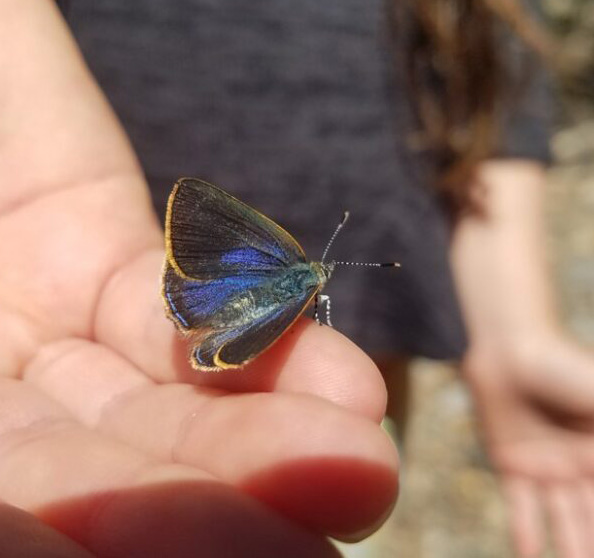
The 2022 butterfly season has begun, with thanks to Hira Walker for her wonderful paraphrasing of Maurice Sendak’s original “wild rumpus” line. As March 2022 drew to a close, Hira and her daughter, Brooke, wasted no time getting out to look for butterflies. Like two or three others among you, they spent some spring time in Water Canyon, southwest of Socorro. Reported Hira: “. . . we spent the day in the Magdalenas yesterday. Pleasantly surprised at the number of butterflies out. Saw maybe 15 species of butterflies – good numbers of Mourning Cloaks, Hoary Commas, and Orangetips. We even got to see our first Spring Whites and Desert Marbles.” I asked her for more and she shared a pic of Brooke holding one of my favorite species (Image 1).
It goes without saying that mariposa wranglers in the Las Cruces area remained active and productive over the past month. As reported by Gordon Berman: “Today along the Rio G, Fred, Judy, and I spotted queens, lupine blue, and what I assume are painted crescents because both Jim and Marta ID’d them there recently. Tamarisk and willow are leafing out and flowering. With only recycled water draining into the Rio, you can easily access portions of the dry river bed where a variety of plants are blooming. Although regrettable, as the Rio here is only a narrow rivulet without any snow runoff at all, one advantage is you can see the trees from east and west, choose your time of day, and always have the sun at your back.” Wise words indeed!
My April began with an April 1 assertion by Marta Reece that Gulf Fritillary had successfully overwintered in Las Cruces, very likely as a chrysalis. I thought she was fooling, but then she shared her photo of an adult from March 31 (Image 2), a new early record for New Mexico and months ahead of the typical summer monsoon invasion. Climate warming maybe?
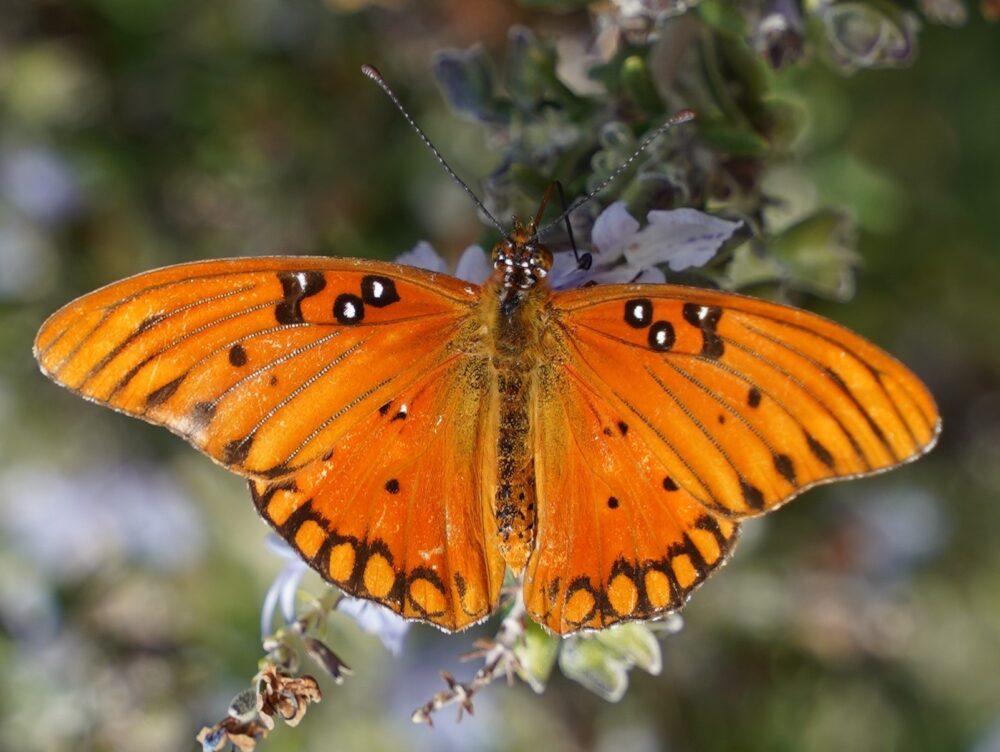
Marcia Corl photographed the infrequently-seen Carus Skipper, along the Rio Grande in Dona Ana County (Image 3). This represents the spring flight of the double-brooded species. For the time being, the Las Cruces area seems to be less drought-afflicted than the rest of New Mexico, so I hope we continue to get interesting reports from Los Cruceños as the season progresses.
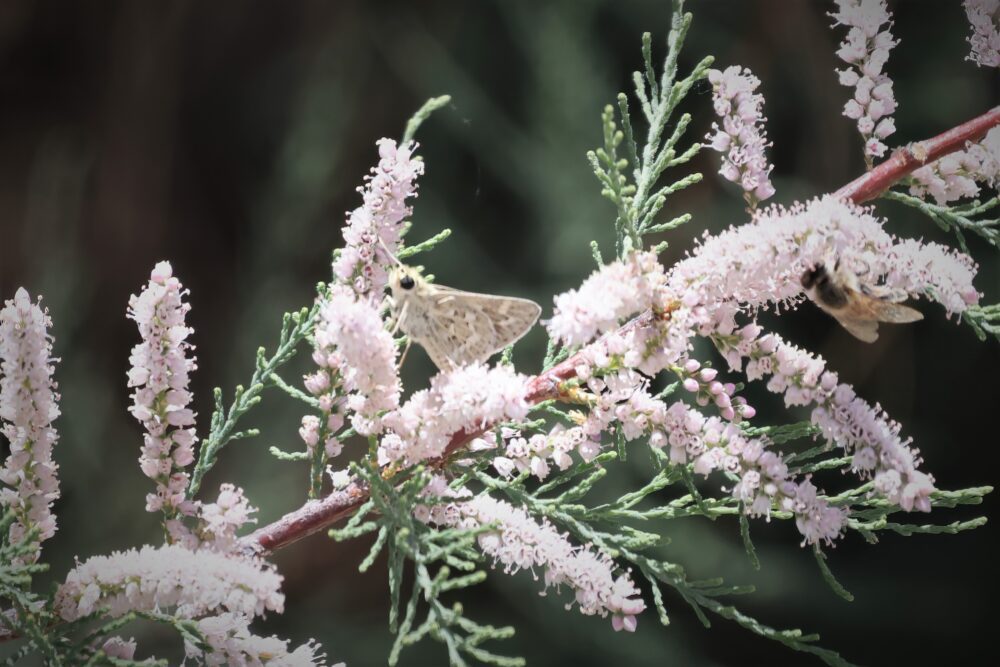
Our two round-trip migrant butterfly species, Monarchs and Painted Ladies, were trickling across the border in late March, but in rather low numbers. Our first sightings of each were in the Las Cruces area (Image 4, left). At this writing Monarchs are being reported in the Albuquerque area and Painted Ladies are all the way to Union County (Image 5, right)! Expect them to continue to spread out, but in low numbers. As you might expect, the unfortunate consequences of our ongoing severe drought include very little nectar for adults, not many thistles to feed Painted Lady caterpillars, and little milkweed to feed Monarch larvae.
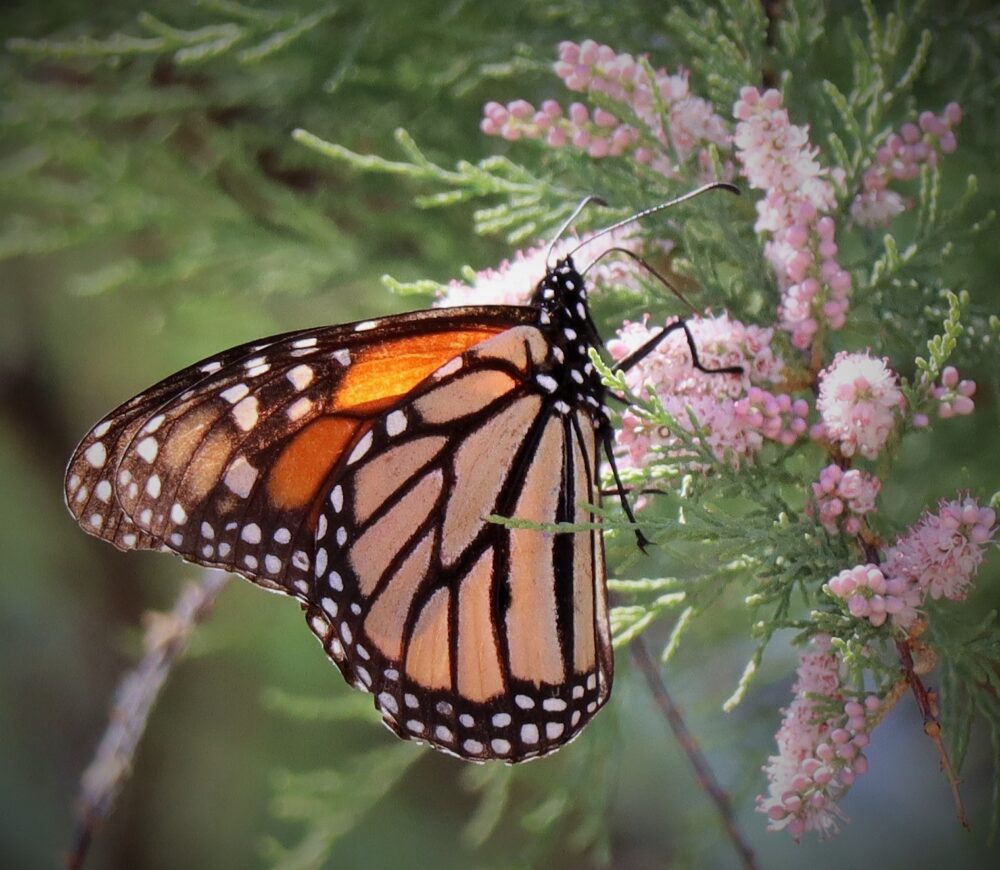
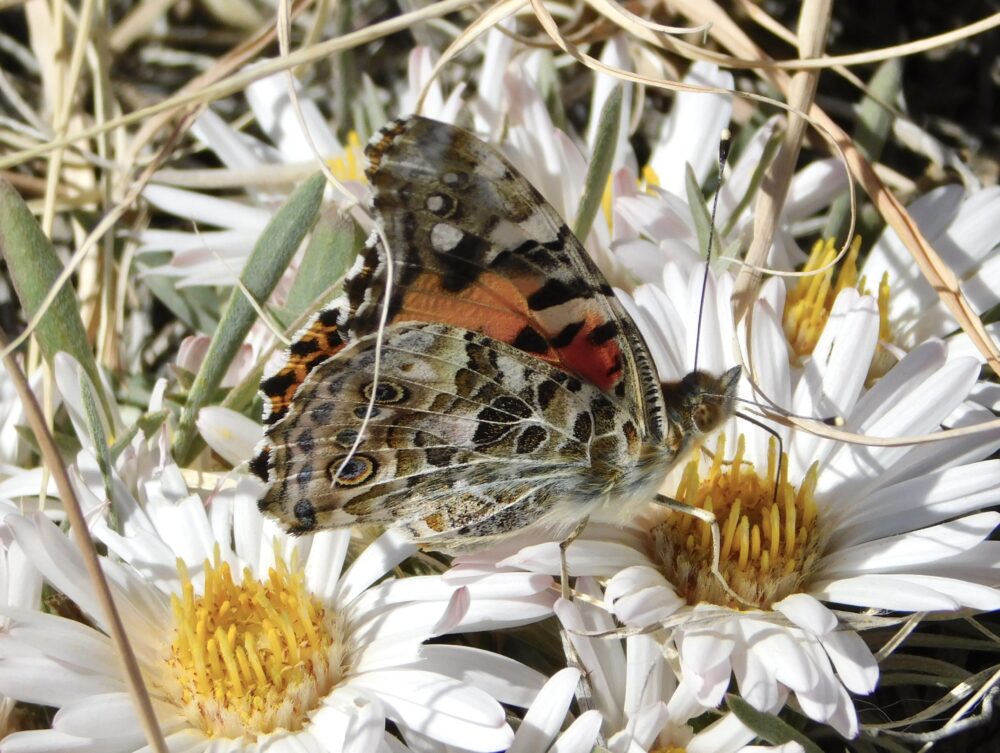
Another Orangetip Adventure. Much farther north, the season is 4 to 6 weeks delayed compared to Las Cruces, and this is normal. That gave me time to study up on orangetips, which many of you have seen and photographed this spring. Personally, I was eyeball-deep into Todd Stout’s momentous 2018 publication in which he, with support from genomics work, demonstrated beyond all doubt that Southern Rocky Mountain Orangetip (Anthocharis julia) occurs in far northern Rio Arriba County, New Mexico.* I had never seen any orangetips that far north in New Mexico and so for many years I did the rational thing – I denied there were any while making no effort to look for them. Confident, yet uninformed, as I am about the Four Corners in general, my cover was blown. Stout’s map (Image 6), reproduced below, left little doubt that I have been overlooking some interesting orangetip biogeography in our Four Corners area.
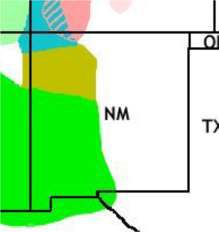

I had to do something to redeem myself so I scheduled an outing for April 9 to look for Southern Rocky Mountain Orangetip in northern New Mexico. Considering the location of Stout’s find, near Dulce, I drove US 64 a little west of there to the westernmost strip of land within the Carson National Forest. As US 64 curves into Vaquero Canyon, I turned north onto a forest road toward Mestena Mesa and Mestena Peak. The dirt road proved to be in a local shale material that is easily rutted and turns to glue when wet. Luckily we are in a drought, so the road was dry and high clearance was all I needed. It was about noon on a mild, mostly sunny day. Only a few miles in, I began to see a few small white butterflies moving through the pinon, juniper and ponderosa pines. Orangetips seek hilltops, but the local landscape showed only modest relief and the trees obscured any obvious high points. So, finally, I just parked the truck and began to walk around, keeping my eyes open. Other than a couple of Spring Whites (Pontia sisymbrii), all the other whites I encountered proved to be orangetips and I was able to get photos of several (Image 7).
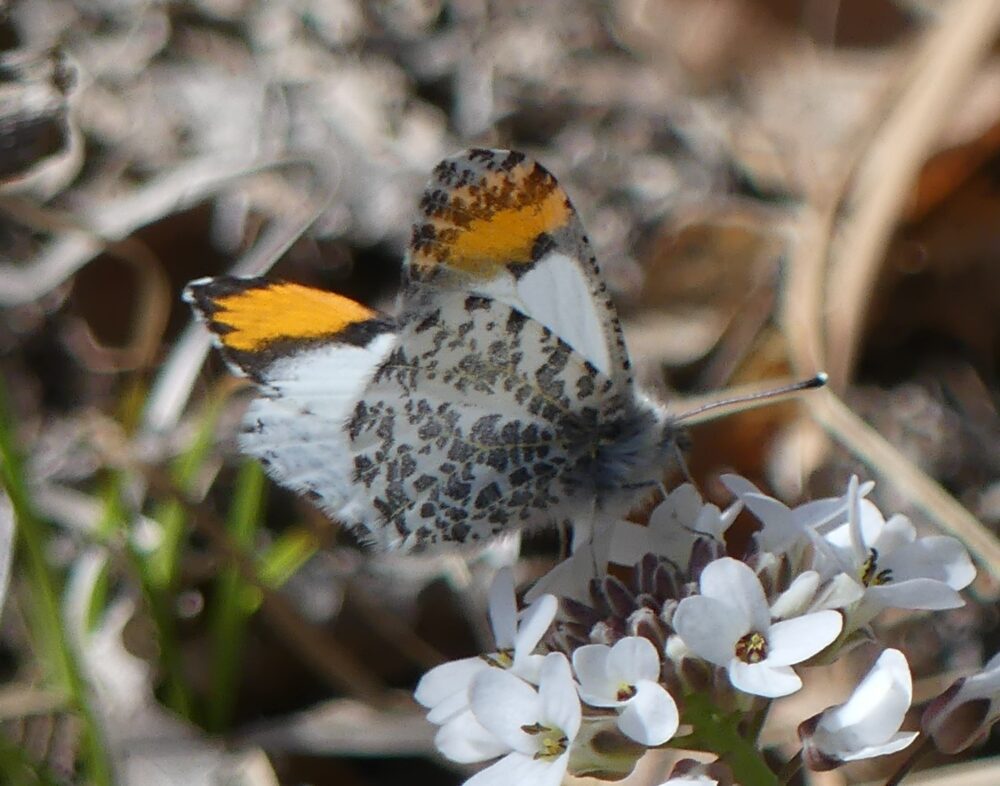
Given my lack of experience with the array of possible orangetip IDs one might reasonably get in this area (see Image 6, Todd Stout’s map) I did not know what I had seen. Was it Anthocharis thoosa subspecies colorado? That would be a new one for me and for New Mexico. Was it A. julia near prestonorum? That’s what Stout found several years earlier about 12 miles to the east, near Dulce. I emailed a couple of my photos to Mike Fisher, who knows west slope Colorado butterflies as well as anyone.** We agreed that on-the-ground boundaries between A. julia and A. thoosa, and then between the various A. thoosa subspecies, are rather indistinct and the diagnostic markings are hard (for me at least) to trace. Mike and I exchanged possible diagnoses via email and, in the end, we agreed that the above butterfly (Image 7) displays the muted, gray-green (grisverde, as he likes to call it) ventral marbling which helps to distinguish A. julia from A. thoosa, whose marbling is very dark and glossy. So I succeeded in my quest to find, document and photograph A. julia in New Mexico! That made my day, my month, and it might have to make my entire season if we don’t get a good monsoon this summer!
* Stout, Todd L. 2018. A review of three species-level taxa of the Anthocharis sara complex (Lepidoptera: Pieridae: Pierinae: Anthocharidini). Insecta Mundi 0615: 1–38.
** Fisher, Michael S. 2005. The Butterflies of Colorado: Pieridae and Papilionidae – Part 5 – The Whites, Sulphurs and Swallowtails. Colorado State University, Fort Collins. 192 pp.
What about those adult hibernators? Over this past month, most of us in the mountains or the north have seen the typical array of butterflies that hibernate as adults, whether Commas, Cloaks or Tortoiseshells. California Tortoiseshells have made a particularly good showing this spring, from the Jemez Mountains (see Image 8) and Sandia Mountains all the way south to the Organ Mountains (thanks for that county record, Christopher).
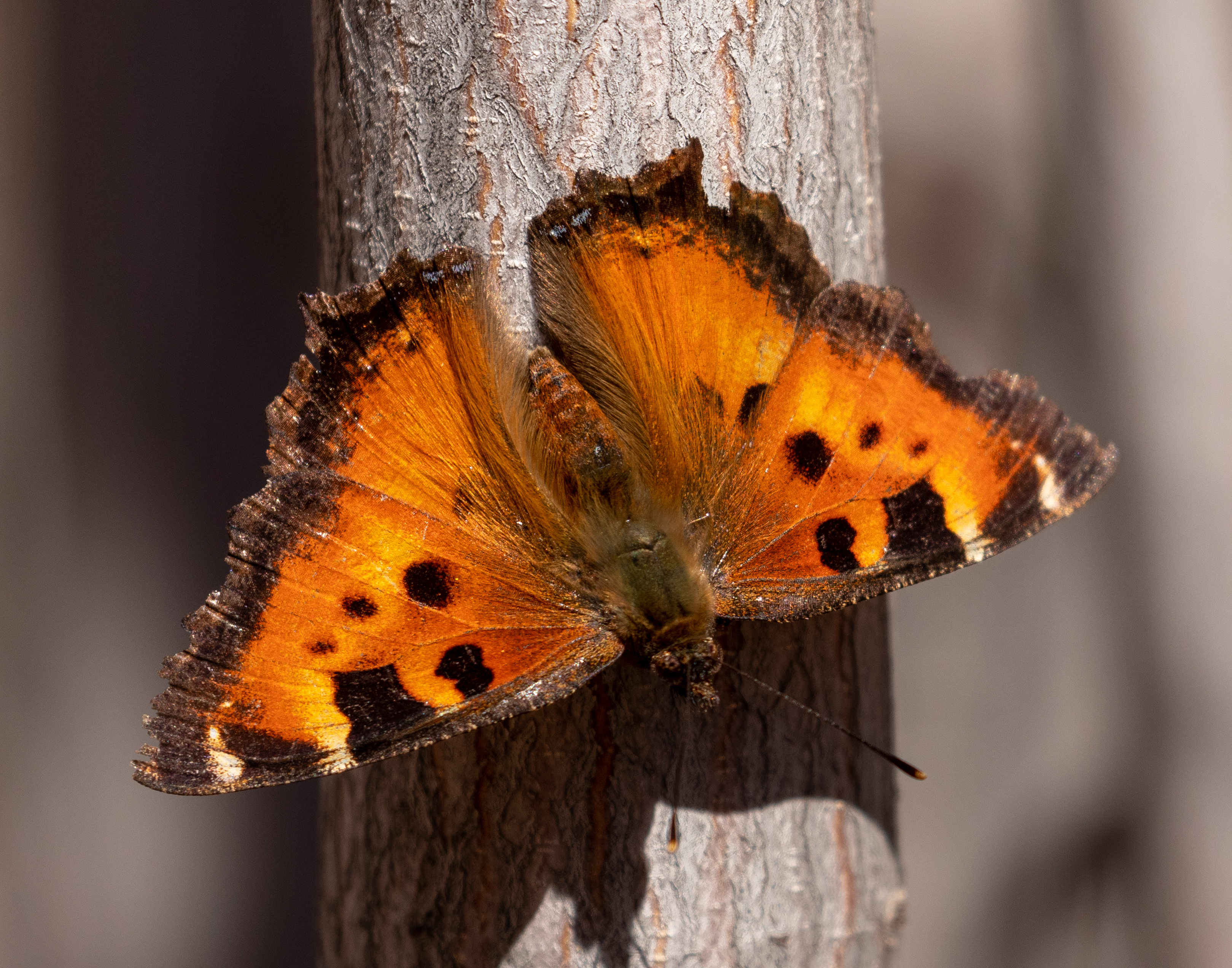
Mourning Cloaks, too, have been widely seen throughout New Mexico, and I have a story about them. I and several other fellows “of a certain age” (i.e., retired) volunteer at the Randall Davey Audubon Center in the hills east of Santa Fe. Each Tuesday we spend the morning tending to whatever infrastructure/grounds/maintenance tasks that Center Manager Carl Beal tells us need doing. On Tuesday April 5, at about 12:00 noon, after wrapping up a tear-down and re-build of one of Randall Davey’s old rock walls, we went back to the administration building to retrieve our lunches. En route, I could not help but notice a small group of visitors who audibly oohed and aahed while deploying cell phone cameras. What was the fuss?
A Mourning Cloak was sunning itself near the visitor center at eye level, so everyone had a nice view. This particular Mourning Cloak proved to be a female and she seemed unusually indifferent to the humans gathering around her. A closer look showed she was not sunning, but ovipositing – placing eggs on the twig of a hackberry tree. She kept at it for quite a while and we all were able to watch, take photos and discuss what was happening. For each butterfly species, the female’s principal duty and her only chance to benefit her offspring is to place eggs on healthy examples of the proper plant, so her offspring wake to food when they emerge from their eggs. For Mourning Cloaks, willows are the preferred hosts, but other deciduous woody plants will do, like the hackberry in this case. For most butterfly species, females place eggs one at a time throughout their habitat, but Mourning Cloaks usually place their eggs in large clusters, like this one (Image 9).
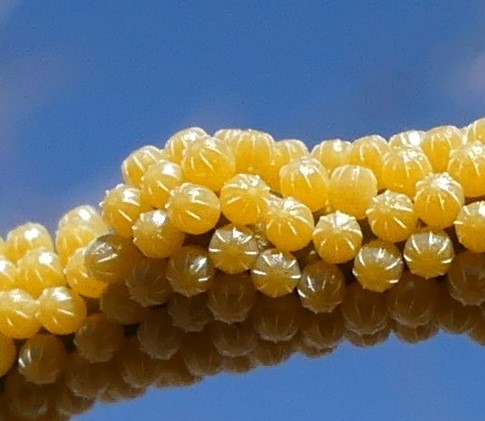
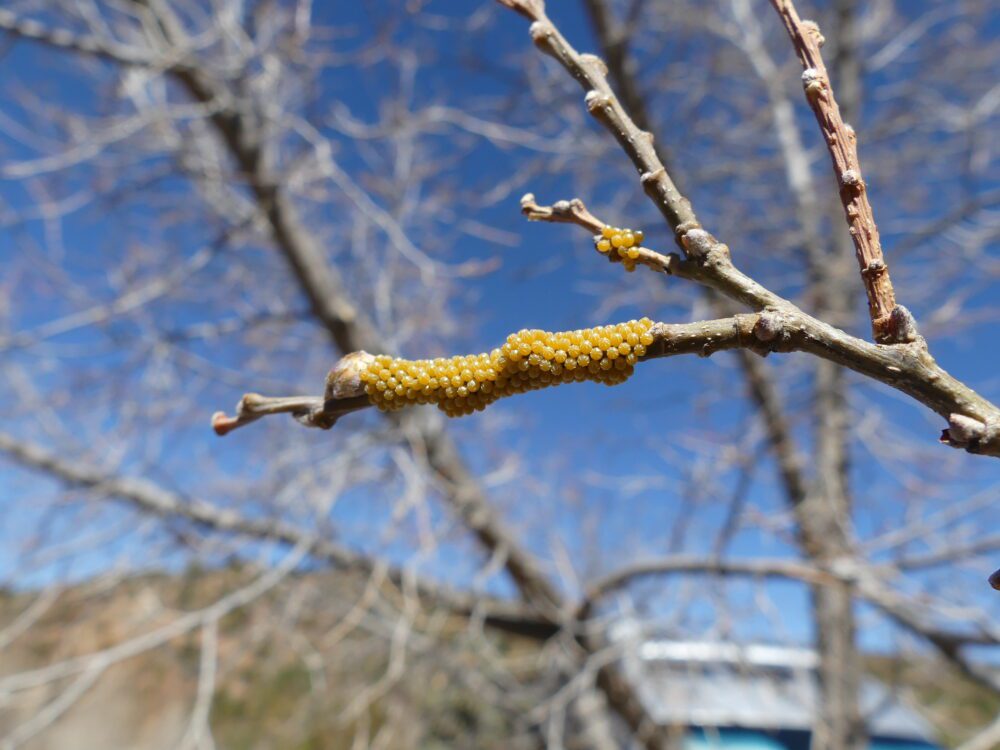
It is rare to get a close look at butterfly eggs. First, one must find them, and then they are tiny, only ~1mm in diameter and hard for humans to see and appreciate. I don’t have the proper camera for decent micro-photography, but I did the best I could (wide angle at 0.5″) and then cropped one resulting photo to get the image above. It is, at least, good enough so you can see that the eggs are not featureless, spherical blobs, but rigid and architectural in their design. I expect there will be some tiny larvae soon. Will they find green hackberry tissues to eat? Will nesting birds find the caterpillars to feed to their young? After all, Audubon is a bird conservation outfit!
One week later (April 12), the egg mass looked like this (Image 10). Eggs had darkened, which is what happens as the inner material is gradually assembled into first instar larvae, which are very dark. Still no signs of eggs hatching, but weather over the previous week was cool, cloudy, stormy and not conducive to egg development.
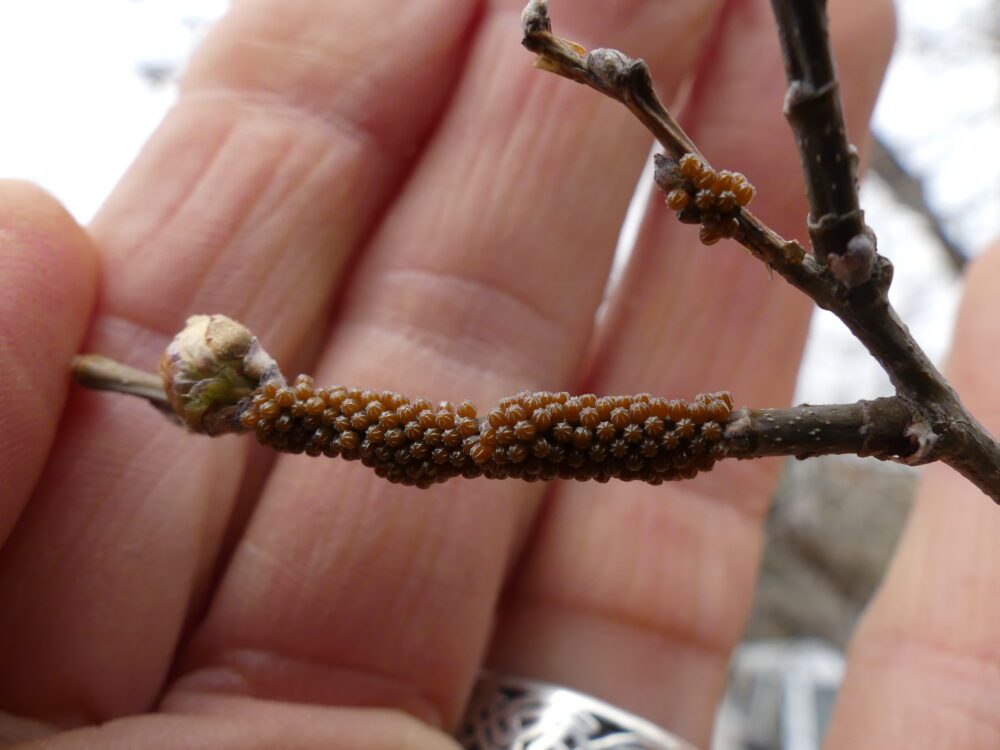
Now, do you see the bulbous feature to the left of the egg mass? THAT is a developing floral bud on the hackberry tree. My fingers are crossed that it will produce its flowers just as the first instars are emerging and looking for something to eat. Do you suppose the female placed the eggs near the bud on purpose? No doubt about it. The plant is investing its best energy there and “Mother Mourning Cloak” put her eggs there so her offspring would have ready access to the good stuff. There are other flower buds in the same general area.
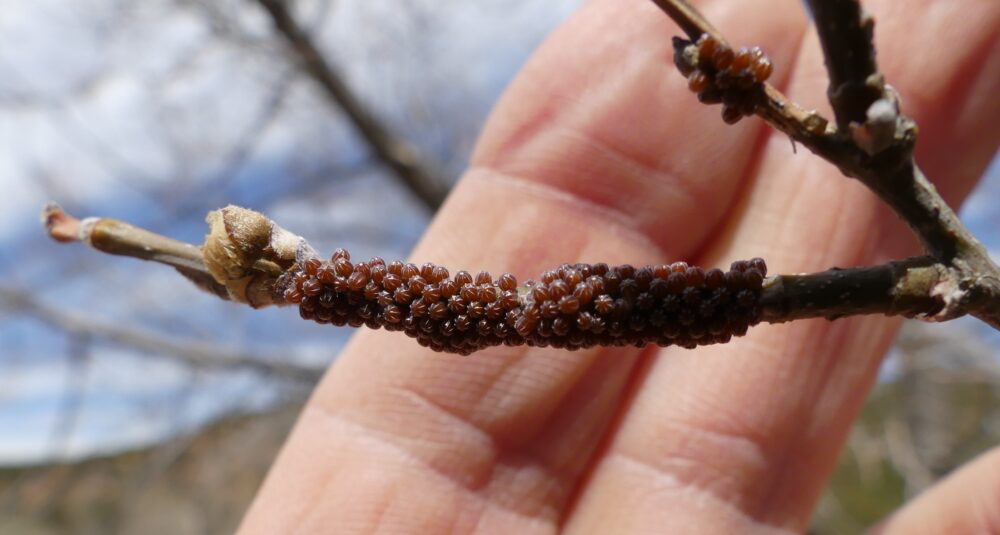
I’ll continue to photograph the scene as spring progresses and we’ll just have to wait to see if we get any of these (see Image 12).
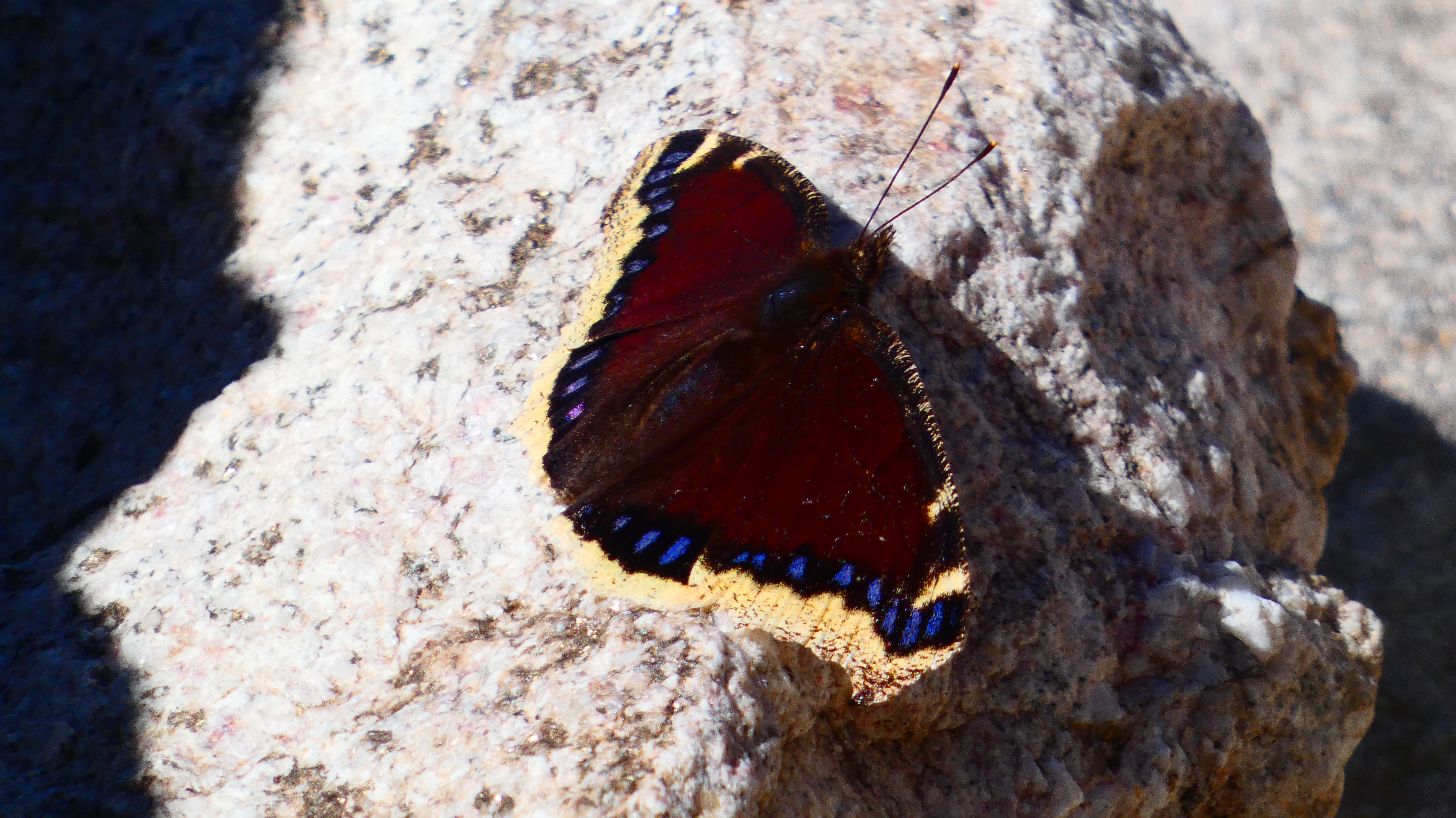
Nightmare Scenario: Is it Sleepy or Dreamy?
For butterfly photographers, the various Duskywing skippers (Hesperiidae: Pyrginae: Erynnis) pose some of the greatest identification challenges within New Mexico’s butterfly fauna. Two that are particularly difficult to distinguish are Sleepy Duskywing (Erynnis brizo) and Dreamy Duskywing (Erynnis icelus), which co-occur across many of our states’ mountain habitats and both of which fly early in the season. Sleepy and Dreamy are easily differentiated from other duskywings in having no (zero) white or translucent spots on their forewings. Instead, our eyes are drawn to the two bands of dark-bordered gray spots. One band is in the forewing median area (at the mid-point of the wing), the other is post-median (beyond the mid-point between wing base and outer edge). Each band arcs (curves) from the leading edge of the forewing (the costa) toward the trailing edge.
Narrowing it down to Sleepy or Dreamy was the easy part, so now what? For butterfly watchers and photographers, here are three clues to distinguish one from the other: (1) palps, (2) wash of silver scales, and (3) gray-ringed abdominal segments. (See comparisons in Image 13)

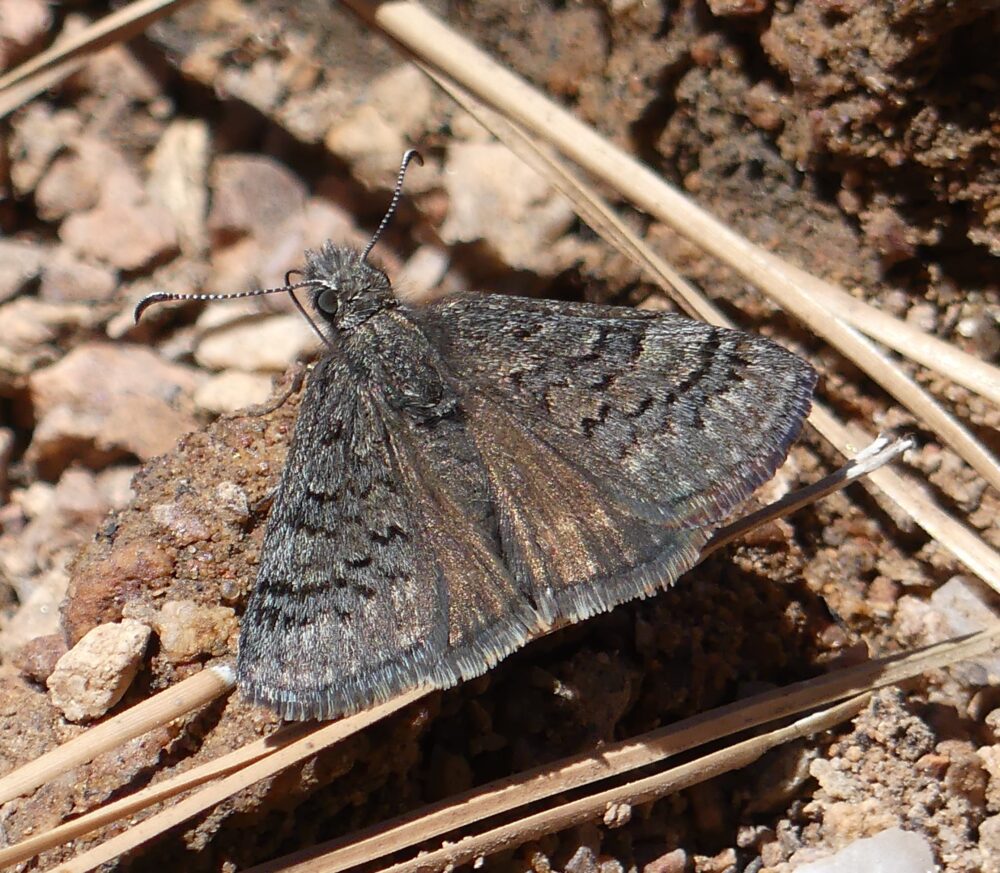
Palps (or palpi) are the fuzzy mouthparts that house the proboscis of all adult butterflies. The palps are covered with sensory hairs and scales that are thought to play a role in feeding. Among all our butterflies, the palps vary in prominence from almost unnoticeable in most cases to, in their most exaggerated state, forming the “snout” of Snout Butterflies. Dreamy Duskywing has two rather prominent palps protruding from the front of its face. Sleepy has smaller palps .
Second, Dreamy Duskywing has a fairly intense wash of silver scales between the two gray forewing bands. This character is somewhat qualitative, however, and becomes less reliable with wear as a butterfly ages. The third clue is the ring of silver/gray scales at the back of each abdominal segment.
If all the above clues fail, habitat might help resolve the matter. Larvae of Dreamy eat aspen foliage, so if you don’t see aspens in the area, then Dreamy is not likely. Larvae of Sleepy eat oak buds and foliage, so if you don’t see oaks of any species in the area, then Sleepy is unlikely. In evaluating habitat, keep in mind that Sleepy males do hilltop assertively, which can carry them up into aspen country. In much of our grassy plains territory, oaks are regular but aspen are absent, so that will be Sleepy terrain. In New Mexico’s higher mountains, aspens and Gambel oaks can live side by side so Sleepy and Dreamy are both possible. So then take another look at palps, abdominal segments and the wing facies.
Meanwhile, and for the past three months, Mike Toliver has continued to prepare distribution maps and additional text and graphics to accompany species accounts in PEEC’s Butterflies of New Mexico. As of this writing, he has upgraded the Swallowtails, White, Sulphurs, and Metalmarks. We are half way through the Hairstreaks. Here is Mike’s map for Southwestern Orangetip (Image 14). You should look up your favorite species and see what you think. Let us know if you like them.
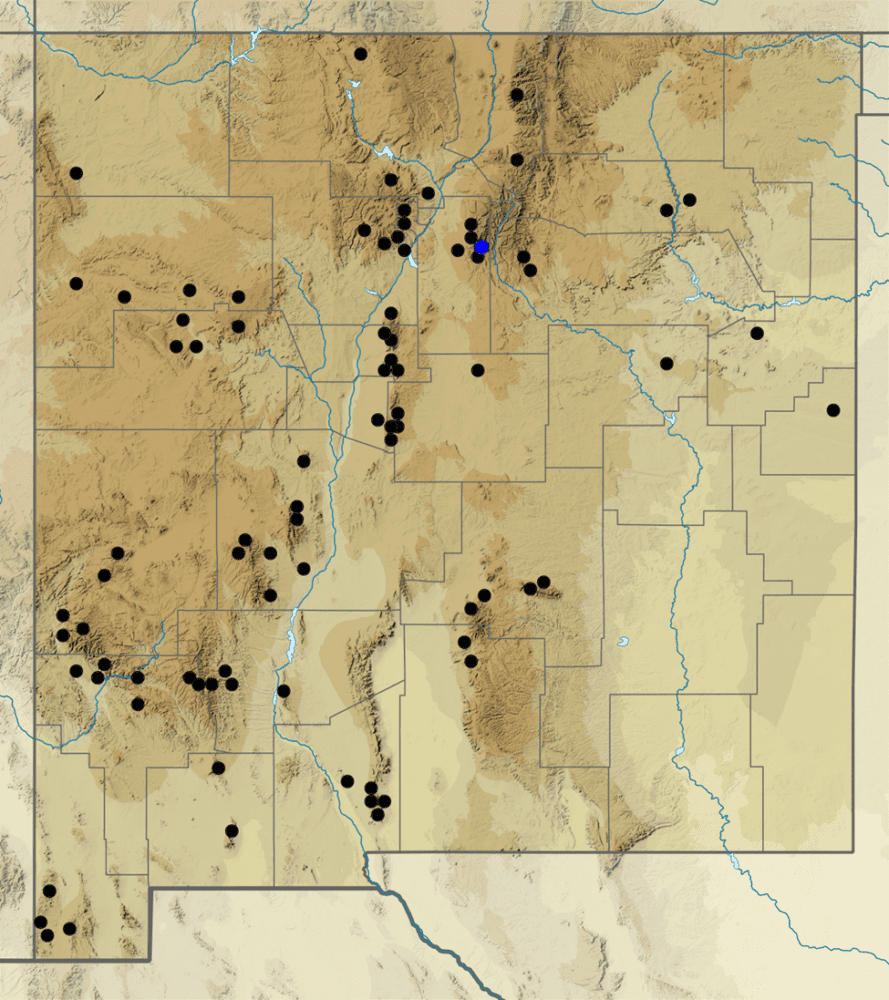
I wish you all continued successes in your butterflying endeavors. While keeping your expectations modest in the early part of this year, let’s also hope for some helpful precipitation (at night, of course) and for fair weather during your outings.

Steve
Another fabulous blog! I never seen eggs of Mourning cloak though I had six caterpillars going into chrysalis stage above my garage door couple of years ago!
Selvi, I’m pleased you saw something new. Now you see how those mourning cloak larvae of yours began their journey.
Steve, I appreciate your documentation of the Mourning Cloak find…something my untrained eyes and mind can get excited about. I look forward to hearing and seeing more about it.
Randy, I’m glad to learn of your excitement! Stay tuned for future developments.
WONDERFUL BLOG! Makes us homebound Coloradoans envious!! I didn’t think Agraulis pupae can overwinter!
Paul, thanks so much for your kind remarks. Glad you enjoyed it! and spring can’t be too far away for you, I hope!
Hi Steve, fascinating that the Mourning Cloak mother lays her eggs near the bud of the tree for her babies to feed off of. Great observation.
That was my conclusion at the time, but stay tuned to see what happens!
Another fascinating blog. The Mourning cloak eggs are amazing. I will look forward to seeing your updates about them. I was also extremely interested in the discussion of the southwestern orangetip since they have been the most common butterfly I’ve seen this early Spring.
Thanks so much,
Rozelle
Rozelle, it’s my pleasure!